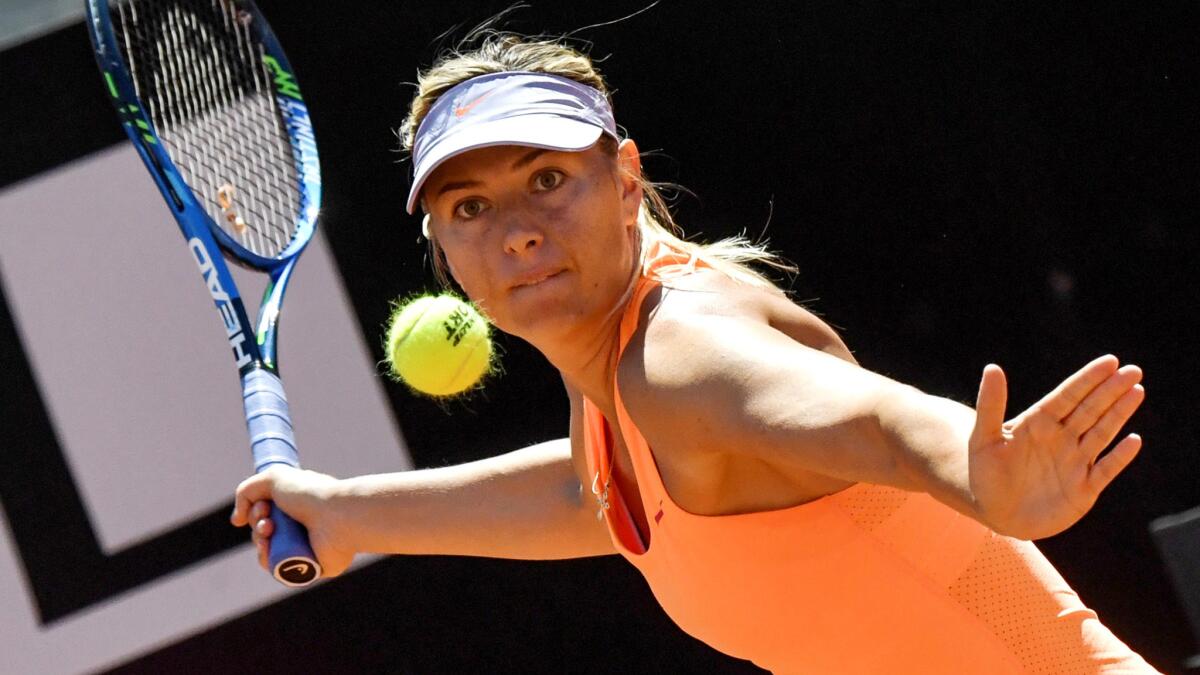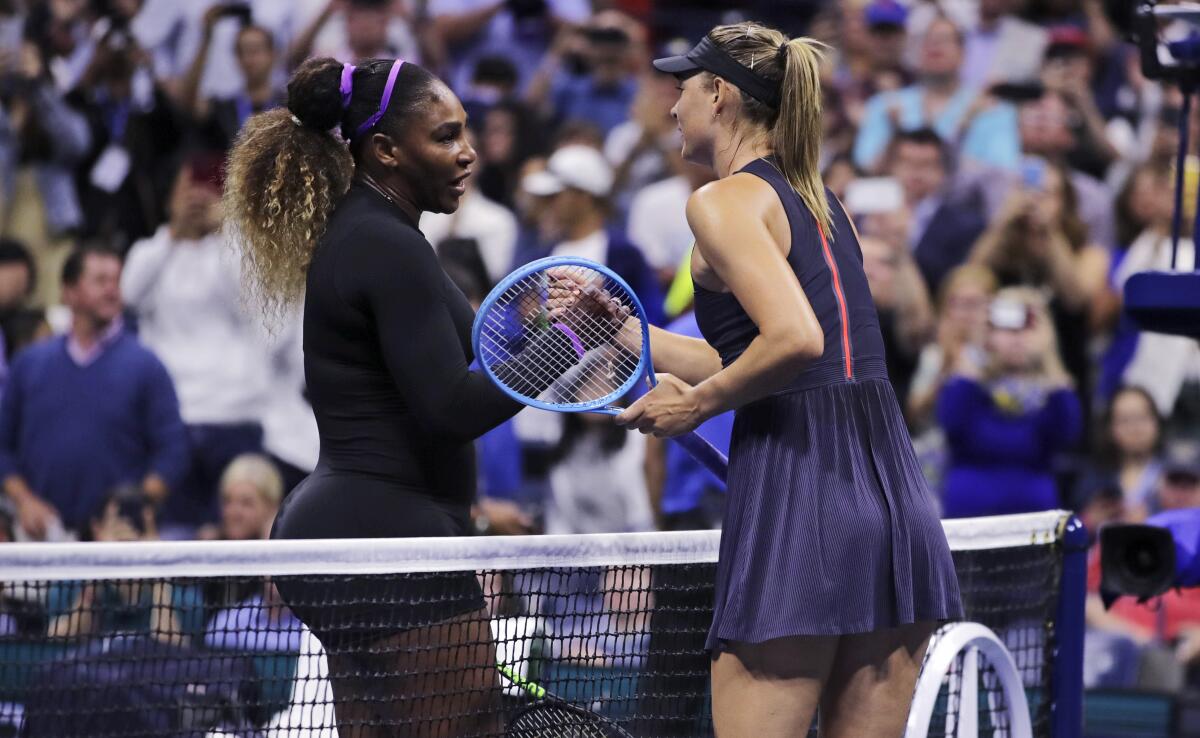Maria Sharapova’s PED suspension should keep her out of the Hall of Fame

- Share via
This week, five-time major champion Maria Sharapova said goodbye to tennis. What is not clear is whether or not the former World No. 1 will get to say hello to the International Tennis Hall of Fame.
That’s because Sharapova is the most accomplished player to be banned for using a performance enhancement drug. In 2016 a tribunal banned her for testing positive for meldonium, which increases stamina and focus. Making matters worse, after serving her 15-month sentence, Sharapova only managed to win one, lower-rank title. Granted, her last years on tour were besieged by a litany of injuries, but the reality is she was not particularly well liked by players before the suspension and was viewed by some players and journalists as nothing more than a despised cheater upon her return.
How the ITHF handles her legacy will be fascinating.
“It’s a ways off,” said Anne Marie McLaughlin, vice president of communications and enshrinement for the hall. “And we’ve already had quite a few retirements announced for this year with the Bryans [Bob and Mike], Leander Paes, Caroline Wozniacki … and it’s only February. That’s a lot deserving players who will be eligible around the same time.”
A player must be retired five years to become eligible. In 2017, however, the ITHF changed its rules to include automatic ballot inclusion for players who have won at least three majors and have been ranked No. 1 for at least a total of 13 weeks. It also allows players who have won at least five majors, such as Sharapova, to be automatically included on the ballot.
“Maria is the first player to have retired who meets the level of accomplishments to be put automatically on the ballot,” McLaughlin said.
Roughly 150 tennis journalists and Hall of Fame members are involved in the voting process. Fan voting is also a factor, which might prove to be an important element as it pertains to Sharapova.
Complex Regional Pain Syndrome nearly ended Coco Vandeweghe’s tennis career, but she’s getting her game back in order.
Despite trailing 20-2 in their head-to-head — and winning less than a fourth as many majors — the 32-year old Sharapova comfortably out-earned Serena Williams in endorsements for most of their time together on tour. She might be viewed as a cheater now, but this speaks to her immense popularity around the world. In fact, when the ban was lifted, tournament directors immediately granted her wild-card entries, recognizing her name still got butts in seats.
And there is also a question of whether voters believe she purposely used the banned substance to gain an unfair advantage. Or do they accept she only took it to treat a heart ailment and address her family’s history of diabetes, as she claimed.
Sharapova had been using meldonium for 10 years and was unaware that it had been newly banned before failing the drug test, she said. The International Tennis Federation and the WTA said it warned players five times the drug would soon be banned before initiating the change. Sharapova acknowledges not reading the emails thoroughly and took responsibility for the failed test.
But will voters believe her excuse?
Do you believe her?
Because you know what? I don’t.
The Latvian chemist who invented the drug said he did so to help Soviet troops breathe better when fighting in the mountains of Afghanistan. The World Anti-Doping Agency announced in 2015 that it was banning the substance in 2016. After the change, more than 170 athletes — nearly all from Eastern Europe — failed the test. We’re talking Olympic medalists from a variety of sports.
Boxer Alexander Povetkin had his title fight against Deontay Wilder called off for testing positive for meldonium. Povetkin claimed it was left over in his system from before it was banned. However, random tests performed more than a month before the scheduled fight — and weeks before the failed test — did not find the substance in his system. In other words, it is clear Povetkin was trying to get a competitive advantage before the fight.

I get not checking emails — Lord knows, it’s among my least favorite things to do. But it’s quite the coincidence to have the one drug designed to help soldiers climb every mountain also be the drug of choice to address all of her ills. Williams’ husband, Alexis Ohanian, isn’t buying it. He threw major shade her way by rocking a D.A.R.E. T-shirt at the U.S. Open while his wife was en route to a 6-1, 6-1 victory over Sharapova.
As we all know, baseball has had to deal with this issue for years and the consensus has been that no one found to have used PEDs gets in the Hall of Fame. But this is tennis’ first brush with the controversy. We’re years away from Sharapova being eligible, but if the journalists who cover this beautiful sport want to protect it they can’t allow time to heal this wound.
Sharapova was an amazing player who battled multiple shoulder injuries to become one of the greatest to pick up a racket. She was known for her powerful groundstrokes, her loud on-court grunts and relentlessness. She also was suspended for using a performance enhancement drug. What Sharapova has done automatically gets her name on the ballot. And what she has done should automatically make her someone voters should not reward.
Baseball doesn’t always handle cheaters the right way (see “Asterisks, Houston”) but it has the Hall of Fame part right.
More to Read
Go beyond the scoreboard
Get the latest on L.A.'s teams in the daily Sports Report newsletter.
You may occasionally receive promotional content from the Los Angeles Times.












